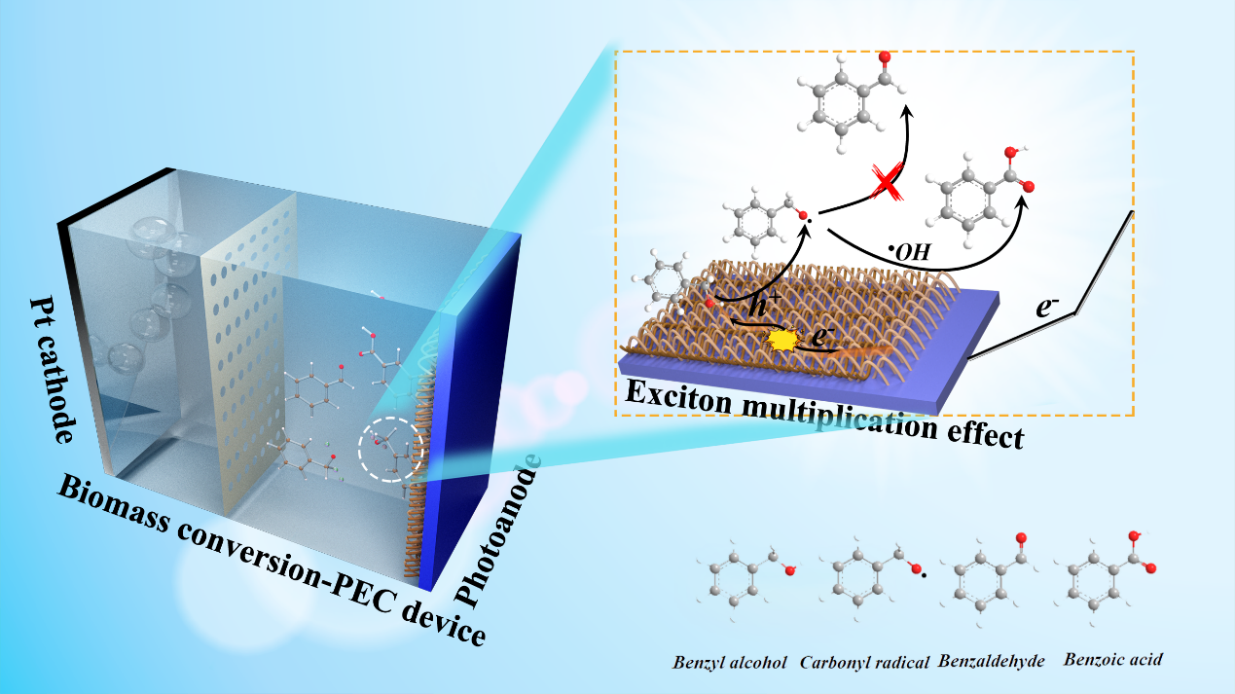光电化学合成醇和氢Non-quantum nanostructures-enabled hot carriers generation for enhancive photoelectrocatalytic oxidation of bio-alcohol in water coupled with hydrogen evolution
Non-quantum nanostructures-enabled hot carriers generation for enhancive photoelectrocatalytic oxidation of bio-alcohol in water coupled with hydrogen evolution
Recently, PhD student Mr Pei-dong Wu supervised by Profs. Hu Li and Zhen Fang published research article in Green Chem about photoelectrocatalytic oxidation of bio-alcohol in water coupled with hydrogen evolution.
Photoelectrochemical system is a promising way for biomass valorization but still in its infancy. Herein, a Mo-BVO-TiCoNO-CoFeOxy photoanode with a nanowire structure was prepared for efficiently converting bio-based benzyl alcohol (BA) to benzoic acid (97.7% yield) for the first time, while coupling H2 production of 136.8 μmol cm-2. The nanowire structure enables a significant increase in the exposed active sites on the photoelectrode surface to enhance the BA oxidation capacity, whereas its large aspect ratio increases the visible light absorption and thermal effect (resulting from size effect) increases H2 production at the counter electrode. DFT calculations and further experiments revealed that Co species of the CoFeOxy layer functioned as stabilizers of photoelectrode property while Fe species acted as catalytic site providers in the BA oxidation.
Publication:
Pei-dong Wu, Lanyun Li, Keping Wang, Hu Li*, Zhen Fang*. Non-quantum nanostructures-enabled hot carriers generation for enhancive photoelectrocatalytic oxidation of bio-alcohol in water coupled with hydrogen evolution, Green Chem., 2023,
https://doi.org/10.1039/D3GC00226H

The use of photoelectrochemical system for the high value use of biomass-derived alcohols coupled with hydrogen production is a significant contribution to the “two-carbon”. The loading of a “two birds with one stone” CoFeOxy layer on BVO substrate enabled rapid separation of photoexctied carriers while achieving a 97.7% yield of benzyl alcohol (BA) to benzoic acid (BEN). 使用光电化学(PEC)的方法将生物质衍生醇高值化利用耦合产氢,对于“双碳”目标的实现具有极大的促进意义。我们在钒酸铋基底上负载具有“一石二鸟”作用的CoFeOxy外层实现光致载流子的快速分离,同时实现对苯甲醇(BA)到苯甲酸(BEN)97.7%的产率。
博士生吴培栋在李虎教授和方真教授的指导下,在国际学术期刊Green Chemistry发表研究性论文:
非量子纳米结构产生热载流子增强光电氧化生物质醇同时耦合产氢的能力
最近,博士生吴培栋在李虎教授和方真教授的指导下,在国际学术期刊Green Chemistry (Q1; Impact factor: 11)上发表了一篇关于光电化学氧化生物质醇到苯甲酸的研究性论文。
PEC氧化系统是一种很有前途的方法可以将生物质高值化利用,但仍处于起步阶段。在此基础上,我们制备了具有纳米线结构的Mo-BVO-TiCoNO-CoFeOxy光阳极,首次将生物质衍生醇-苯甲醇(BA)高效转化为苯甲酸(收率97.7%),同时偶联H2产量为136.8 μmol cm-2。纳米线结构使暴露在光电极表面的活性物显著增加,从而增强BA氧化能力,而其较大的纵横比增加了其可见光吸收,同时产生的热效应(由尺寸效应引起)增加了对电极H2的产量。DFT计算和对照实验表明,CoFeOxy层中的Co物种是光电极性能的稳定剂,Fe物种在BA氧化的过程中提供了催化位点。
详情可见:
Pei-dong Wu, Lanyun Li, Keping Wang, Hu Li*, Zhen Fang*. Non-quantum nanostructures-enabled hot carriers generation for enhancive photoelectrocatalytic oxidation of bio-alcohol in water coupled with hydrogen evolution, Green Chem., 2023,